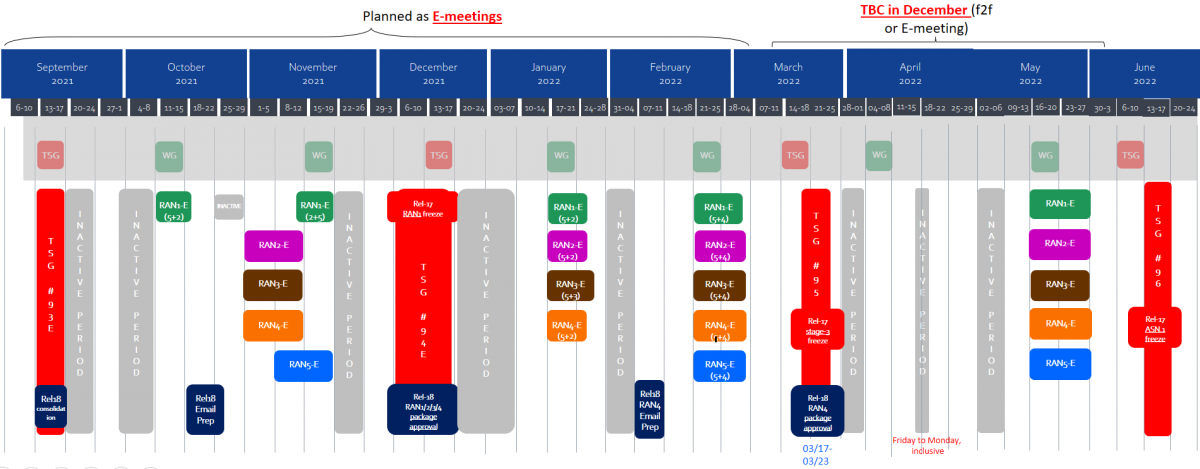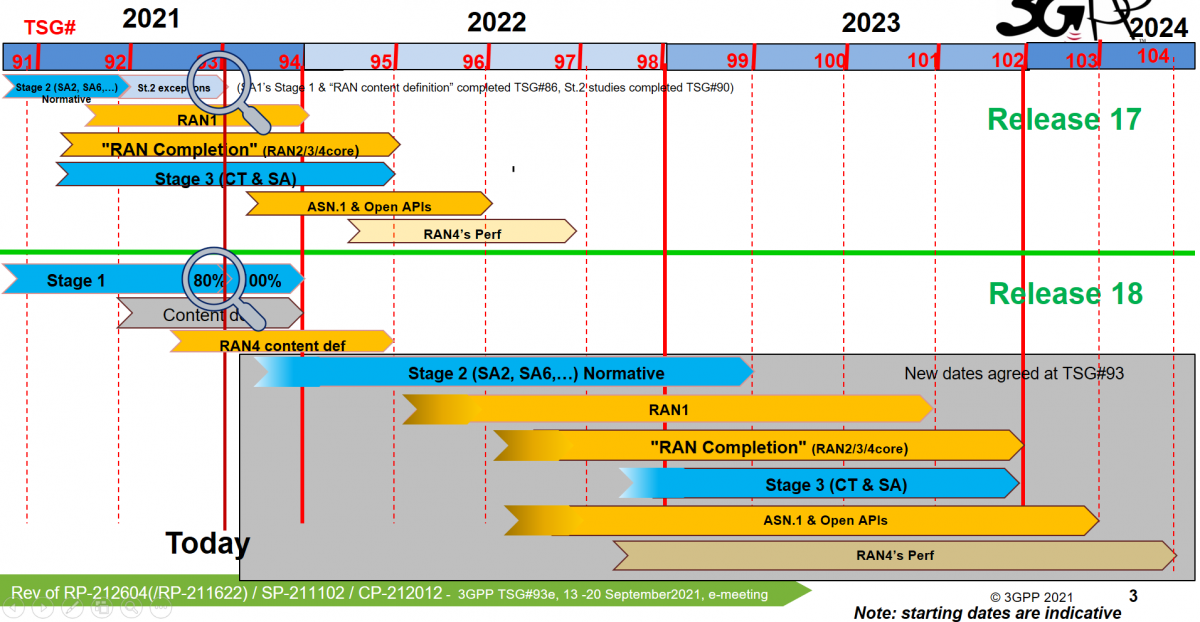Summary Report from RAN#93e (Electronic meeting, 13 - 17 September 2021)
This report comes from RAN specialist, Hans van der Veen, NEC Laboratories Europe GmbH and member of the 5G-IA Pre-Standardization WG .It is a summary of 3GPP TSG RAN#93e. Because of the COVID-19 virus, the meeting was held as an electronic meeting. For the first time, more than 1000 documents were submitted. However, none of the detailed Rel-18 submissions were treated. Instead, Rel-18 was treated at high level (timeline, topics for further email discussion, coordination with SA and CT).
RAN Planning and Release 17

RAN meeting planning (Endorsed: RP-212587)
The Rel-17 completion dates remain unchanged, but RAN1 and RAN2/3/4 will focus on finishing Rel-17 in Q1 2022 and H1 2022 respectively. All RAN WG meetings until March 2022 will be electronic.
Rel-17
Rel-17 Planning (No changes in planning, but still many unfinished Stage 2 Work Items)
Stage 1: frozen December 2019 with exceptions; all remaining Stage 1 work was completed by June 2020
RAN "Feature Packaging" ("Content definition") achieved December 2019
Stage 2: frozen June 2021 with exceptions; in September 2021 still many unfinished Work Items (see list below)
RAN1: freezing target December 2021
RAN2 and RAN3: freezing target March 2022
Stage 3: freezing target March 2022
ASN.1 and open APIs: freezing target June 2022
RAN4: freezing target September 2022
Rel-17 Stage 2 Work Items not yet finished in TSG SA
- Support for Minimization of service Interruption (MINT)
- Non-Public Networks (eNPN)
- 5G Location Services) (eLCS)
- Uncrewed Aerial System (UAS)
- Integration of satellite components (5GSAT)
- Application layer support for V2X services (eV2XARC)
- Multicast-Broadcast (5MBS)
- Edge computing (eEDGE)
- Network Slicing (eNS)
- Multi-USIM (MUSIM)
- Network Automation (eNA)
- Proximity Services (5G_ProSe)
- Application Architecture for MSGin5G Service (5GMARCH)
- Multimedia Priority Service (MPS)
- Architecture support for NB-IoT/eMTC Non-Terrestrial Networks in EPS (IoT_SAT_ARCH_EPS)
- Architecture Enhancement for NR Reduced Capability Devices (ARCH_NR_REDCAP)
Rel-17 Closed Work Items and Study Items (excluding spectrum-related and conformance testing)
The following Rel-17 work was completed and the corresponding SIs and WIs closed:
NR
- SI: Study on scenarios and requirements of in-coverage, partial coverage, and out-of-coverage NR positioning use cases
LTE
- <None>
Rel-17 Work Item Summaries (descriptions of features in the release after the work has actually finished)
- <None>
- SP-210890 WI summary on Enhancement of Network Slicing Phase 2
Rel-17 NR: Sidelink positioning (Approved pCR: RP-212037; Approved TR: RP-212038; Summary: RP-212550)
This Study Item was finished and closed.
Rel-17 NR: Further enhancements on MIMO (Approved revised WID: RP-212535; Summary: RP-212552)
All companies preferred or accepted to remove the objective "Investigate if the requirements on link recovery procedure is suitable for FR2 serving cells [RAN4]", and this was the only revision to the WID.
Rel-17 NR: Reduced Capability (Summary: RP-212634)
Band n79 can be supported by RedCap UEs. No consensus on whether a RedCap UE can support V2X/PC5 on n47, unlicensed bands, SUL bands. In Rel-17, there will be no work on any RedCap specific specification update for any of the following:
- RedCap UEs also supporting V2X/PC5 on n47
- RedCap UEs operating in unlicensed bands
- RedCap UEs supporting Supplementary Uplink (SUL)
The specification will not contain any explicit restriction to prevent implementation of RedCap UEs with these features.
Note: The consequence of this agreement would be: If any spec change/addition is found necessary in order to enable one of the options above then it will not happen in Rel-17.
Rel-17 NR: UE power saving enhancements (Approved revised WID: RP-212630; Summary: RP-212611)
Support PDCCH-based Paging Early Indication (PEI) as the only option.
Rel-17 NR: MBS (Summary: RP-212559)
The following aspects are within the scope of Rel-17:
• Configurable scrambling sequence initialization for PDCCH/PDSCH and DMRS sequence generator initialization for PDCCH/PDSCH for broadcast transmission (as supported for RRC_CONNECTED UE).
• Configuring TRS as QCL sources for broadcast transmission (as supported for RRC_CONNECTED UE).
Rel-17 NR: IAB enhancements (Summary: RP-212560)
Enhancements to improve topology-wide fairness and multi-hop latency to be deprioritized.
RAN2-led efforts on enhancements to LCG-range extension, RLF indications and local rerouting to continue.
Rel-17 NR: Small Data Transmissions (Approved revised WID: RP-212594; Summary: RP-212561)
RRC-less SDT was removed from the scope of SDT WI.
Rel-17 NR: Sidelink Relay (Approved revised WID: RP-212601; Summary: RP-212563)
The revised WID adds non-relay discovery (e.g. 5G ProSe Direct Discovery) as objective. For 5G ProSe Direct Discovery RAN2 takes the agreement for relay-based discovery achieved as baseline while enhancements and optimizations beyond basic functionality for the 5G ProSe Direct Discovery scenario are not considered.
Rel-17 NR: WI UPIP support for EPC connected architectures using LTE and EN-DC (Postponed WI: RP-212297; Summary: RP-212588)
RAN did not achieve consensus on introducing UPIP support for EPC connected architectures using LTE and EN-DC, although this is requested and supported by SA/SA3.
Rel-17 NR: UE capabilities (Approved CR: RP-212623; Summary: RP-212569)
The topic of UE categories or profiles for URLLC is still contentious, and the status of the discussion as captured at RAN#92e still applies. RAN approved a CR to introduce an informative Annex in TR 38.822 on listing of Rel-15 features relevant for URLLC.
Rel-17 LTE: NB-IoT/eMTC support for NTN (Approved LSout: RP-212617; Summary: RP-212609)
RAN asked CT and CT1 possible support for discontinuous coverage. RAN WGs will continue work on discontinuous coverage as already planned. Should there be no support for discontinuous coverage at NAS, the scope of the RAN WID may be adjusted.
Approved Work Items and Study Items (excluding spectrum-related and conformance testing)
- <None>
RAN Release 18

Rel-18 Planning (freezing targets beyond Stage 1 set)
Stage 1: freezing target December 2021
RAN1/2/3 WI/SI package approval planned for December 2021
RAN4-led WI/SI approval planned for March 2022
Stage 2: freezing target March 2023
RAN1: freezing target September 2023
RAN2/3/4 Core: freezing target December 2023
Stage 3: freezing target December 2023
ASN.1 and open APIs: freezing target March 2024
RAN4: freezing target June 2024
RAN Rel-18 planning: Content of email discussion 20-29 October (Endorsed: RP-212608)
Content was discussed at high level only during this meeting. All RAN#93e inputs that fit the following list will be inputs for the next email discussion from 20-29 October. The goal is to start deriving RAN/1/2/3/4 WIs and SIs from consolidated proposals.
List of Potential RAN1-led Items
MIMO Evolution for Downlink and Uplink
UL Enhancements (e.g. coverage enhancements; excluding MIMO)
Additional topological improvements – smart repeater
Sidelink enhancements (excluding positioning and relaying)
RedCap Evolution
Expanded and improved Positioning
Evolution of Duplex Operation
AI (Artificial Intelligence)/ML (Machine Learning) for Air interface
Network energy savings
List of Potential RAN2-led Items
Mobility Enhancements
Enhancements for XR
Sidelink Relay Enhancements
NTN (Non-Terrestrial Networks) evolution
Evolution for broadcast and multicast services
UAV (Uncrewed Aerial Vehicle)
Multiple SIM (MUSIM) Enhancements
In-Device Co-existence (IDC) Enhancements
List of Potential RAN3-led Items
Additional topological improvements - IAB/VMR
AI/ML for NG-RAN
SON/MDT Enhancements
QoE Enhancements
One single email thread for discussion of all potential RAN4-led Items
Additional email threads (one for each topic) to be used to discuss the following potential RAN2/3-led topics
Inter-gNB coordination, with the following example areas:
- Inter-gNB/gNB-DU multi-carrier operation
- Inter-gNB/gNB-DU multi-TRP operation
- Enhancement for resiliency of gNB-CU
UE aggregation
High-speed Packetization
SDT (small data transmission)
CA (Carrier Aggregation)/DC (Dual-Connectivity) enhancements (excluding mobility aspects)
- Eg., MR-MC (Multi-Radio/Multi-Connectivity), multi-CC scheduling, flexible spectrum integration, etc.
Note: discussion for the following topics is postponed (i.e., not discussed in 4Q'21) due to dependency on SA
- Network slicing enhancements (depending on SA2)
- Security enhancements (depending on SA3)
An email thread is to be used to discuss passive IoT for the purpose of better understanding
